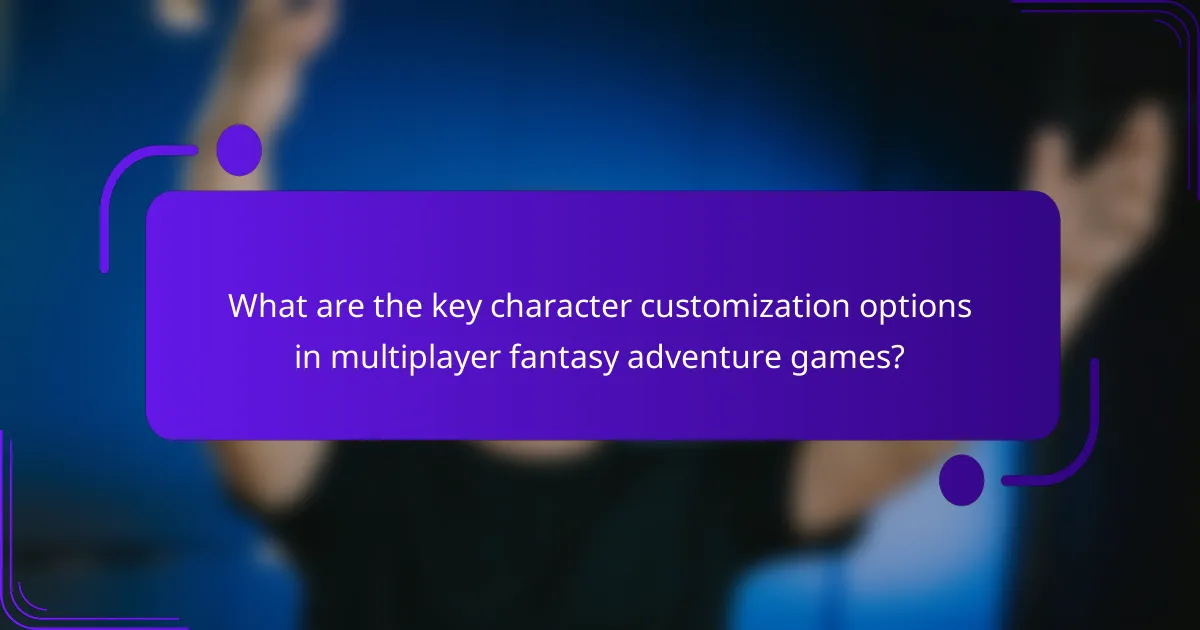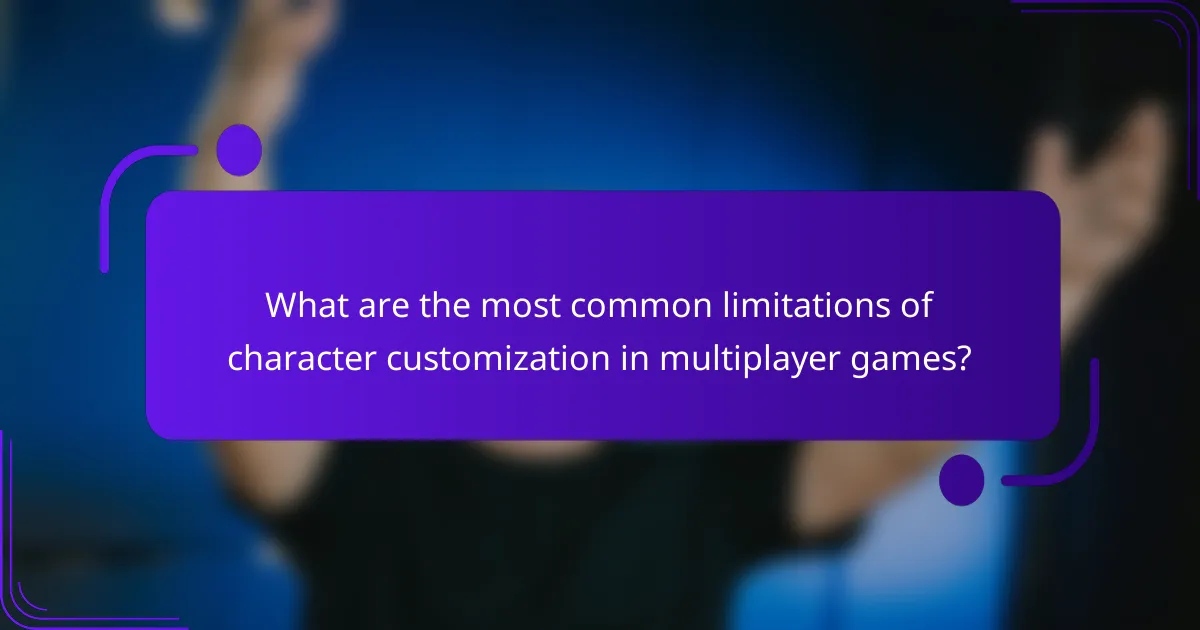Character customization options in multiplayer fantasy adventure games enhance player engagement and immersion. Players can adjust appearance, skills, and equipment to fit diverse playstyles. Character classes shape these choices, influencing gameplay strategies and aesthetics. Progression unlocks advanced options, while limitations can impact individuality and satisfaction.

What are the key character customization options in multiplayer fantasy adventure games?
Character customization in multiplayer fantasy adventure games includes options for appearance, skills, and equipment. Players can typically adjust physical traits like hair, body type, and facial features. Skill trees allow for unique character builds, enhancing gameplay strategies. Equipment customization often involves choosing weapons, armour, and accessories that influence stats and abilities. These options cater to diverse playstyles, enhancing player engagement and immersion.
How do visual customization features enhance player experience?
Visual customization features significantly enhance player experience by fostering personal expression and immersion. Players can tailor their characters’ appearances, which cultivates a sense of ownership and connection to the game. This personalization leads to increased engagement, as players feel more invested in their unique avatars.
Moreover, diverse customization options, such as skin tones, outfits, and accessories, cater to varied player preferences, promoting inclusivity. Enhanced visual appeal also enriches the gaming environment, making it more vibrant and enjoyable. Ultimately, these features contribute to a more dynamic and memorable gaming experience.
Which gameplay mechanics are influenced by character customization?
Character customization significantly influences gameplay mechanics such as character abilities, progression systems, and combat strategies. Customization options allow players to tailor their characters, impacting skills and playstyles. For example, selecting a specific class can enhance unique abilities, while visual choices can affect player perception and immersion. Additionally, character attributes like strength or agility may be modified through customization, directly influencing gameplay dynamics.

How do character classes affect customization choices?
Character classes significantly shape customization choices by defining gameplay styles and available options. Each class offers unique abilities and attributes, influencing player decisions on aesthetics and functionality. For instance, a warrior class may prioritise strength and durability, leading to armour and weapon choices that enhance these traits. Conversely, a mage class focuses on intelligence and magic, encouraging options that boost spellcasting abilities. This class-based framework ensures that customization aligns with gameplay strategies, enhancing the overall experience.
What unique abilities do different classes offer?
Different classes in multiplayer fantasy adventure games offer unique abilities that enhance gameplay. Each class typically specializes in specific roles, such as damage dealing, healing, or tanking, which allows for diverse strategies.
For example, a mage class may possess powerful area-of-effect spells, while a warrior class excels in close combat with high durability. Unique abilities can include stealth for rogues or summoning for necromancers. These distinctions create varied gameplay experiences and encourage teamwork among players.
How do class-specific traits shape gameplay strategies?
Class-specific traits significantly influence gameplay strategies by defining abilities, strengths, and weaknesses. Players tailor their approaches based on these traits to maximize effectiveness in various scenarios. For instance, a tank character excels in absorbing damage, while a healer focuses on support and sustainability. This differentiation encourages collaboration among players, as each class brings unique attributes to the group dynamic. Additionally, understanding these traits allows players to exploit enemy weaknesses and adapt strategies accordingly, enhancing overall gameplay experience.

What role does cosmetic customization play in player identity?
Cosmetic customization significantly enhances player identity in multiplayer fantasy adventure games. It allows players to express individuality through unique character appearances, fostering a deeper emotional connection to their avatars. This personalization influences gameplay experience and social interactions within the game world. Customization options, such as skins, outfits, and accessories, serve as visual representations of player achievements and preferences, reinforcing their presence in the gaming community. Ultimately, cosmetic choices contribute to a player’s sense of belonging and identity within the game narrative.
How do cultural influences shape cosmetic choices in different regions?
Cultural influences significantly shape cosmetic choices in different regions by reflecting local values and aesthetics. For instance, in East Asian cultures, lighter skin tones are often preferred, while in many African cultures, vibrant colours and bold designs are celebrated.
Regional trends are influenced by historical context, religious beliefs, and social norms. In Western countries, there is a growing trend towards natural and sustainable beauty products, reflecting a shift in consumer values towards health and environmental consciousness.
Additionally, social media plays a crucial role in disseminating beauty standards, often leading to a blending of cultural influences. This creates diverse cosmetic choices that cater to a global audience while still honouring local traditions.
Ultimately, understanding these cultural influences helps brands tailor their products and marketing strategies to resonate with specific demographics, enhancing consumer engagement and satisfaction.
Which trends are emerging in character aesthetics for 2025?
Emerging trends in character aesthetics for 2025 focus on personalization, realism, and inclusivity. Players increasingly seek unique customization options that reflect personal identities and styles.
Enhanced facial features and body types will dominate, allowing deeper immersion. Advanced graphics technology will enable more realistic textures and animations, creating lifelike characters.
Additionally, diverse cultural influences will shape character designs, promoting representation. This trend will foster a broader range of aesthetics, appealing to varied player demographics.
Incorporating user-generated content will also rise, as communities contribute their designs, enhancing creativity and engagement in multiplayer fantasy adventure games.

How does character progression impact customization options?
Character progression significantly enhances customization options in multiplayer fantasy adventure games. As players advance, they unlock new abilities, gear, and aesthetic choices that reflect their unique playstyle.
Higher character levels often lead to access to advanced skill trees, allowing for deeper specialization. Players can tailor their characters to fit specific roles, such as tank, healer, or damage dealer. This flexibility encourages diverse gameplay experiences and fosters player engagement.
Moreover, character progression may introduce rare items and exclusive customization features, such as unique skins or mounts. These elements not only differentiate players but also promote a sense of achievement and investment in the game world.
In summary, character progression enriches customization options, enabling players to create distinct identities and strategies within the game.
What are the implications of level-based customization systems?
Level-based customization systems enhance player engagement and satisfaction by allowing tailored character development. These systems offer diverse options, fostering unique gameplay experiences. Players can invest time in specific attributes, impacting strategy and social interaction. As a result, customization becomes a significant factor in player retention and community building in multiplayer fantasy adventure games.
How do skill trees integrate with customization features?
Skill trees enhance character customization by allowing players to tailor abilities and attributes. Players can choose skills that align with their playstyle, creating unique character builds. This integration fosters deeper engagement and strategic gameplay. For example, a player may focus on offensive skills while another prioritises defence, showcasing the versatility of customization options in multiplayer fantasy adventure games.

What are the most common limitations of character customization in multiplayer games?
Character customization in multiplayer fantasy adventure games often faces limitations such as restricted options, lack of depth, and performance issues. Players may encounter a limited selection of character classes, races, or visual styles, which can hinder individuality. Additionally, some games prioritise gameplay mechanics over customization, leading to superficial options. Technical constraints can also affect the customization experience, resulting in slower performance or bugs. These limitations can detract from player immersion and satisfaction.
How do technical constraints affect customization depth?
Technical constraints limit customization depth by restricting the range of available options and the complexity of character modifications. Constraints such as hardware capabilities, software architecture, and design choices impact how detailed and varied character customization can be. For instance, lower-end devices may not support intricate graphics or extensive customization features, leading to simplified options. Additionally, game engines may impose limits on the number of customizable attributes, affecting the uniqueness of characters. As a result, players may experience a more constrained and less personalized gameplay experience.
What are players’ biggest frustrations with current customization systems?
Players’ biggest frustrations with current customization systems include limited options, lack of meaningful choices, and poor user interfaces. Many feel that customization does not significantly impact gameplay or character identity. Additionally, time-consuming processes and technical issues further diminish the experience. These challenges hinder player engagement and satisfaction in multiplayer fantasy adventure games.

What innovative customization features are being introduced in 2025?
In 2025, multiplayer fantasy adventure games will introduce advanced character customization features. Players can expect enhanced facial morphing tools, dynamic clothing options that adapt to gameplay, and intricate skill trees that reflect individual playstyles. These innovations will allow for deeper personalization, creating unique avatars that enhance player immersion. Additionally, AI-driven customization suggestions based on gameplay behaviour will further tailor the experience, making each character distinct and engaging.
How are AI and machine learning shaping character customization?
AI and machine learning enhance character customization by offering dynamic, personalized options. These technologies analyse player behaviour and preferences, enabling unique character traits and appearances based on individual playstyles. AI-driven algorithms can generate diverse visual options and adjust attributes in real-time, creating a more immersive experience. Additionally, machine learning can predict player choices, allowing for tailored quests and interactions that further enrich character development.
Which games are leading the way in unique customization experiences?
Games leading the way in unique customization experiences include “Elden Ring,” “Final Fantasy XIV,” and “World of Warcraft.” These titles offer extensive character customization options, allowing players to tailor appearance, abilities, and playstyles.
“Elden Ring” features a deep character creation system with diverse classes and skill sets. “Final Fantasy XIV” allows for intricate visual customization, including race, gender, and detailed appearance options. “World of Warcraft” provides unique races and classes, enabling distinct character identities.
These games exemplify how customization enhances player engagement and personal connection to the game world.
What best practices should developers follow for effective customization?
Developers should prioritise user experience, flexibility, and creativity for effective customization in character design. Implementing a robust customization system enhances player engagement and satisfaction.
1. Offer a wide variety of options, including physical attributes, clothing, and accessories.
2. Ensure intuitive navigation for customization menus, allowing players to easily modify their characters.
3. Incorporate feedback mechanisms, enabling players to share their designs and suggestions.
4. Allow for real-time previews of changes, helping players visualize their customizations immediately.
5. Consider performance impacts, optimizing customization features to maintain smooth gameplay.
6. Regularly update customization options to keep content fresh and encourage ongoing player investment.